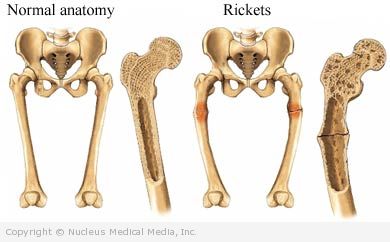Rickets and Osteomalacia – Definition
Rickets (in children) and osteomalacia (in adults) are two forms of a metabolic bone disease resulting from vitamin D deficiency. Both cause softening and weakening of bones because of defective or inadequate bone mineralization.
Rickets and Osteomalacia – Causes
Rickets and osteomalacia result when there is a vitamin D deficiency in the body. This may occur when:
- The supply of vitamin D from the diet or sun exposure is inadequate.
- The metabolism of vitamin D is abnormal.
- Tissue is resistant to the action of vitamin D.
Vitamin D regulates calcium absorption in the body. It also controls levels of calcium and phosphate in bone. Vitamin D is absorbed in the intestines from food. Vitamin D is also produced by the skin during exposure to sunlight.
Most often, rickets and osteomalacia are caused by a deficiency of vitamin D. This can result from:
- Insufficient vitamin D in the diet. In children, this may be related to:
- Insufficient consumption of vitamin D-fortified milk
- Insufficient intake of vitamin D supplements to children being breastfed or to children who are lactose intolerant
- Lack of exposure to sunlight.
Less often, rickets and osteomalacia can be caused by other disorders that affect vitamin D absorption, metabolism, or action in the body such as:
- Kidney problems:
- A hereditary disorder of the kidney called vitamin D-resistant rickets
- Renal tubular acidosis—a nonhereditary kidney disorder which causes bone calcium to dissolve
- Chronic kidney failure
- Long-term kidney dialysis
- Diseases of the small intestines with malabsorption
- Disorders of the liver or pancreas disease
- Cancer
- Certain drugs, such as:
- Certain seizure medications, such as phenytoin (Dilantin, Phenytek) or phenobarbital (Luminal Sodium)
- Acetazolamide (Diamox)
- Ammonium chloride
- Disodium etidronate (Didronel)
- Fluoride treatment
- Toxicity or poisoning from:
- Cadmium
- Lead
- Aluminum
- Outdated tetracycline
Rickets and Osteomalacia – Risk Factors
A risk factor is something that increases your chance of getting a disease or condition. Risk factors for rickets/osteomalacia include:
- Lack of sun exposure
- Age in children: 6 to 24 months old
- Babies who are breastfed (Breast milk is low in vitamin D.)
- Babies who do not consume enough formula that is fortified with vitamin D
- Children who do not drink enough vitamin D fortified milk
- Age in adults: 50-80 years
- Lactose intolerance with inadequate intake of vitamin D-fortified milk
- Family history of rickets
- Race: Black, especially in association with breastfeeding
Rickets and Osteomalacia – Symptoms
Symptoms may include:
- Bone pain and tenderness
- Skeletal and/or skull deformities
- Bow legs or knock knees
- Deformity or curvature of the spine
- Pigeon chest (forward protrusion of the chest bone)
- Impaired growth, resulting in short stature
- Susceptibility to bone fractures
- Dental deformities
- Delayed tooth formation
- Defects in teeth
- Increased cavities
- Loss of appetite or weight loss
- Difficulty sleeping
- Poor muscle development and tone
- Muscle weakness
- Delay of learning to walk in children
Rickets and Osteomalacia – Diagnosis
The doctor will ask about your symptoms and medical history, and perform a physical exam. Tests to confirm the diagnosis may include:
- Blood and urine tests
- X-ray — a test that uses radiation to take a picture of structures inside the body, in this case, bones
- Bone biopsy (when other tests are not conclusive)
Rickets and Osteomalacia – Treatment
Treatment attempts to:
Correct the underlying cause
Relieve or reverse symptoms
Treating the Underlying Cause
Treatment of the underlying cause may include:
- Adding the following to your diet:
- Vitamin D-fortified dairy products
- Foods high in vitamin D (such as fatty fish, egg yolk, and green vegetables)
- Supplements of vitamin D, calcium, and other minerals
- Biologically active vitamin D
- Adequate but not excessive exposure to sunlight
Treating Symptoms
Treatment to relieve or correct symptoms may include:
- Wearing braces to reduce or prevent bony deformities
- In severe cases, surgery to correct bony deformities
Rickets and Osteomalacia – Prevention
To help prevent rickets or osteomalacia:
- Drink vitamin D-fortified milk.
- Consume sufficient vitamin D, calcium, and other minerals. If you think your diet may be deficient, talk with your doctor about alternate sources of vitamins and minerals.
- Get sufficient, but not excessive, exposure to sunlight. Fifteen minutes a day is usually considered sufficient. Any longer than that requires sun protection with clothing or sunscreens, especially in fair-skinned infants or children. Children with dark skin and their mothers are at increased risk for rickets and may need more sun exposure and dietary supplementation with vitamin D.
- Breastfed babies and bottlefed babies who do not get enough vitamin-D fortified formula may need to be given a supplement starting within the first few days of life. Children not getting at least 400 units of vitamin D from their diet may also need supplements. Talk to the doctor to make sure your child is meeting the nutritional requirements for vitamin D.

